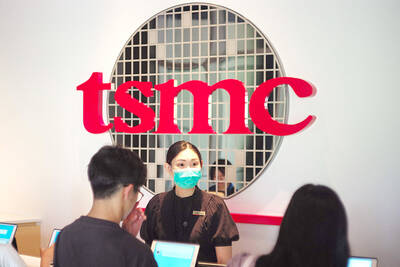South Korea’s economy in the first quarter suffered the worst contraction since the global financial crisis, with a darkening outlook for global trade suggesting that the nation might fail to grow this year.
GDP shrank 1.4 percent in the three months through last month from the prior quarter, slightly above economists’ forecast of a 1.5 percent contraction, the Bank of Korea said yesterday.
Falling consumption was the biggest drag as the COVID-19 pandemic weighed on sentiment and kept people homebound.
From this quarter, the main risk to South Korea’s growth is global trade as markets in the US, Europe and Japan grind to a halt. Chip exports, the country’s biggest source of income, appear to be losing momentum again as the pandemic hurts demand.
As bad as South Korea’s economy performed last quarter, it is still likely to have fared far better than other major economies, a testament to the nation’s success in containing the virus without lockdowns.
The outlook now depends largely on how strongly consumption rebounds, the speed of stimulus efforts and the depth of the global trade slump.
South “Korea was in control of its COVID-19 outbreak much earlier than anywhere else apart from China,” wrote Robert Carnell, chief economist for Asia Pacific at ING Groep NV in Singapore.
“Most of the weakness in 2Q will relate to the global backdrop rather than domestic weakness,” Carnell wrote.
Shocks to South Korea’s trade-reliant economy could widen this quarter as the global recession deepens, the South Korean Ministry of Finance said in a separate statement.
Another wave of virus cases could also complicate efforts to offset trade headwinds with consumer spending, the ministry said.
South Korea is considering relaxing its social distancing rules and reopening schools next month, but disease control officials have warned that the odds of a second outbreak are high.
Bank of Korea Governor Lee Ju-yeol this month said that the economy would probably eke out growth this year, but at a rate of less than 1 percent.
Central bank statistics official Park Yang-su, speaking after the GDP report, said that growth this year would require semiconductor exports gathering momentum and the virus being brought under control at home and abroad.
“If all of these factors combine to serve as a positive factor, it wouldn’t be a very bad growth figure,” Park said.
Government stimulus kept the first quarter contraction from being worse and is likely to continue to play a significant role.
So far, the government has pledged at least 245 trillion won (US$199 billion) in spending, loans and guarantees to shore up the economy.
“South Korea got its outbreak over with faster than other advanced economies did,” DB Financial Investment strategist Moon Hong-cheol said. “What happens in the second-quarter depends a lot on how quickly stimulus measures can be passed.”

Taiwan Transport and Storage Corp (TTS, 台灣通運倉儲) yesterday unveiled its first electric tractor unit — manufactured by Volvo Trucks — in a ceremony in Taipei, and said the unit would soon be used to transport cement produced by Taiwan Cement Corp (TCC, 台灣水泥). Both TTS and TCC belong to TCC International Holdings Ltd (台泥國際集團). With the electric tractor unit, the Taipei-based cement firm would become the first in Taiwan to use electric vehicles to transport construction materials. TTS chairman Koo Kung-yi (辜公怡), Volvo Trucks vice president of sales and marketing Johan Selven, TCC president Roman Cheng (程耀輝) and Taikoo Motors Group

Among the rows of vibrators, rubber torsos and leather harnesses at a Chinese sex toys exhibition in Shanghai this weekend, the beginnings of an artificial intelligence (AI)-driven shift in the industry quietly pulsed. China manufactures about 70 percent of the world’s sex toys, most of it the “hardware” on display at the fair — whether that be technicolor tentacled dildos or hyper-realistic personalized silicone dolls. Yet smart toys have been rising in popularity for some time. Many major European and US brands already offer tech-enhanced products that can enable long-distance love, monitor well-being and even bring people one step closer to

RECORD-BREAKING: TSMC’s net profit last quarter beat market expectations by expanding 8.9% and it was the best first-quarter profit in the chipmaker’s history Taiwan Semiconductor Manufacturing Co (TSMC, 台積電), which counts Nvidia Corp as a key customer, yesterday said that artificial intelligence (AI) server chip revenue is set to more than double this year from last year amid rising demand. The chipmaker expects the growth momentum to continue in the next five years with an annual compound growth rate of 50 percent, TSMC chief executive officer C.C. Wei (魏哲家) told investors yesterday. By 2028, AI chips’ contribution to revenue would climb to about 20 percent from a percentage in the low teens, Wei said. “Almost all the AI innovators are working with TSMC to address the

Malaysia’s leader yesterday announced plans to build a massive semiconductor design park, aiming to boost the Southeast Asian nation’s role in the global chip industry. A prominent player in the semiconductor industry for decades, Malaysia accounts for an estimated 13 percent of global back-end manufacturing, according to German tech giant Bosch. Now it wants to go beyond production and emerge as a chip design powerhouse too, Malaysian Prime Minister Anwar Ibrahim said. “I am pleased to announce the largest IC (integrated circuit) Design Park in Southeast Asia, that will house world-class anchor tenants and collaborate with global companies such as Arm [Holdings PLC],”